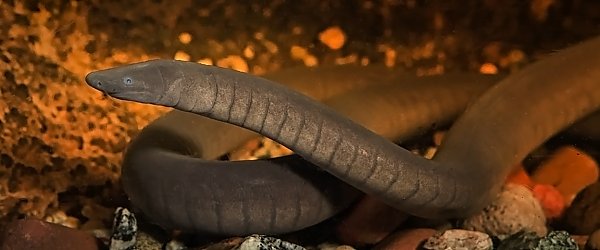Rio Cauca Caecilian
Typhlonectes natans
The name caecilian (pronounced seh-SILL-ian) is from the Latin caecus meaning blind, referring to this animal’s small or non-existent eyes. They belong to an ancient order of amphibians that has been around since before the dinosaurs. Caecilians are aquatic, limbless, worm-like animals with small or no eyes and chemosensory “tentacles” located on their head. They have smooth, dark gray-black skin. This species is not endangered and able to thrive in polluted waters.

SPECIES IN DETAIL
Rio Cauca Caecilian
Typhlonectes natans
CONSERVATION STATUS: Least concern
CLIMATE CHANGE: Not Applicable
At the Aquarium
Look for these animals in the Life Cycle display in the FROGS: Dazzling and Disappearing exhibit in the Tropical Gallery.
Geographic Distribution
Found in the drainage systems of the Cauca and Magdalena Rivers, northern and western Colombia, and the general area of Venezuela’s Lake Maracaibo Basin.
Habitat
Rarely found on land, this aquatic species lives in marshes, rivers, and lakes. It can thrive in polluted water.
Physical Characteristics
Caecilians belong to an ancient third order of amphibians. They are limbless amphibians living underground or in tropical waters. T. natans is a dark grey-black-colored, eel-like animal living in lakes, marshes, and rivers. Its mouth is recessed under a very long snout. They are nearly blind but are able to tell the difference between light and dark. Unique chemosensory organs called tentacles are located on their head near their nostrils and eyes, which help them find food and sense predators. Most of their oxygen is absorbed from the water through their skin, but they are occasionally observed breathing air at the surface. They have a pair of lungs, but the left one tends to be smaller than the right.
Size
17 to 22 inches (45 to 55 cm) in length.
Diet
Caecilians feed on invertebrates, including worms, spiders, and insects.
Reproduction
Fertilization is internal. Males have a penis-like organ called a phallodeum, which is inserted into the female cloaca for two to three hours. This is a viviparous species that gives birth to live, fully developed offspring. During development, secretions from the oviduct walls nourish the embryos. Cells in the oviduct walls are stimulated by the embryos using specialized fetal teeth to produce the secretions. Gestation is from six to seven months. Average litters are between two and eleven offspring.
Behavior
Caecilians are believed to be solitary, but their behavior is not well known.
Adaptation
These animals have adapted very well to their lifestyle, despite having no limbs or eyes.
Longevity
Caecilian’s lifespan in the wild is unknown, but in captivity they can live four to five years.
Conservation
Caecilians are listed as a species of Least Concern by the International Union for Conservation of Nature. This species can tolerate polluted water and is resilient to major water quality degradation.
SPECIES IN DETAIL | Print full entry
Rio Cauca Caecilian
Typhlonectes natans
CONSERVATION STATUS: Least concern
CLIMATE CHANGE: Not Applicable
Look for these animals in the Life Cycle display in the FROGS: Dazzling and Disappearing exhibit in the Tropical Gallery.
Found in the drainage systems of the Cauca and Magdalena Rivers, northern and western Colombia, and the general area of Venezuela’s Lake Maracaibo Basin.
Rarely found on land, this aquatic species lives in marshes, rivers, and lakes. It can thrive in polluted water.
Caecilians belong to an ancient third order of amphibians. They are limbless amphibians living underground or in tropical waters. T. natans is a dark grey-black-colored, eel-like animal living in lakes, marshes, and rivers. Its mouth is recessed under a very long snout. They are nearly blind but are able to tell the difference between light and dark. Unique chemosensory organs called tentacles are located on their head near their nostrils and eyes, which help them find food and sense predators. Most of their oxygen is absorbed from the water through their skin, but they are occasionally observed breathing air at the surface. They have a pair of lungs, but the left one tends to be smaller than the right.
17 to 22 inches (45 to 55 cm) in length.
Caecilians feed on invertebrates, including worms, spiders, and insects.
Fertilization is internal. Males have a penis-like organ called a phallodeum, which is inserted into the female cloaca for two to three hours. This is a viviparous species that gives birth to live, fully developed offspring. During development, secretions from the oviduct walls nourish the embryos. Cells in the oviduct walls are stimulated by the embryos using specialized fetal teeth to produce the secretions. Gestation is from six to seven months. Average litters are between two and eleven offspring.
Caecilians are believed to be solitary, but their behavior is not well known.
These animals have adapted very well to their lifestyle, despite having no limbs or eyes.
Caecilian’s lifespan in the wild is unknown, but in captivity they can live four to five years.
Caecilians are listed as a species of Least Concern by the International Union for Conservation of Nature. This species can tolerate polluted water and is resilient to major water quality degradation.

